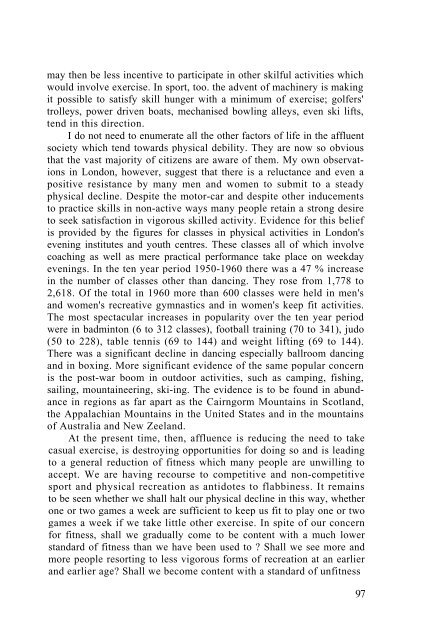download - IOA
download - IOA
download - IOA
You also want an ePaper? Increase the reach of your titles
YUMPU automatically turns print PDFs into web optimized ePapers that Google loves.
may then be less incentive to participate in other skilful activities which<br />
would involve exercise. In sport, too. the advent of machinery is making<br />
it possible to satisfy skill hunger with a minimum of exercise; golfers'<br />
trolleys, power driven boats, mechanised bowling alleys, even ski lifts,<br />
tend in this direction.<br />
I do not need to enumerate all the other factors of life in the affluent<br />
society which tend towards physical debility. They are now so obvious<br />
that the vast majority of citizens are aware of them. My own observations<br />
in London, however, suggest that there is a reluctance and even a<br />
positive resistance by many men and women to submit to a steady<br />
physical decline. Despite the motor-car and despite other inducements<br />
to practice skills in non-active ways many people retain a strong desire<br />
to seek satisfaction in vigorous skilled activity. Evidence for this belief<br />
is provided by the figures for classes in physical activities in London's<br />
evening institutes and youth centres. These classes all of which involve<br />
coaching as well as mere practical performance take place on weekday<br />
evenings. In the ten year period 1950-1960 there was a 47 % increase<br />
in the number of classes other than dancing. They rose from 1,778 to<br />
2,618. Of the total in 1960 more than 600 classes were held in men's<br />
and women's recreative gymnastics and in women's keep fit activities.<br />
The most spectacular increases in popularity over the ten year period<br />
were in badminton (6 to 312 classes), football training (70 to 341), judo<br />
(50 to 228), table tennis (69 to 144) and weight lifting (69 to 144).<br />
There was a significant decline in dancing especially ballroom dancing<br />
and in boxing. More significant evidence of the same popular concern<br />
is the post-war boom in outdoor activities, such as camping, fishing,<br />
sailing, mountaineering, ski-ing. The evidence is to be found in abundance<br />
in regions as far apart as the Cairngorm Mountains in Scotland,<br />
the Appalachian Mountains in the United States and in the mountains<br />
of Australia and New Zeeland.<br />
At the present time, then, affluence is reducing the need to take<br />
casual exercise, is destroying opportunities for doing so and is leading<br />
to a general reduction of fitness which many people are unwilling to<br />
accept. We are having recourse to competitive and non-competitive<br />
sport and physical recreation as antidotes to flabbiness. It remains<br />
to be seen whether we shall halt our physical decline in this way, whether<br />
one or two games a week are sufficient to keep us fit to play one or two<br />
games a week if we take little other exercise. In spite of our concern<br />
for fitness, shall we gradually come to be content with a much lower<br />
standard of fitness than we have been used to ? Shall we see more and<br />
more people resorting to less vigorous forms of recreation at an earlier<br />
and earlier age? Shall we become content with a standard of unfitness<br />
97

















